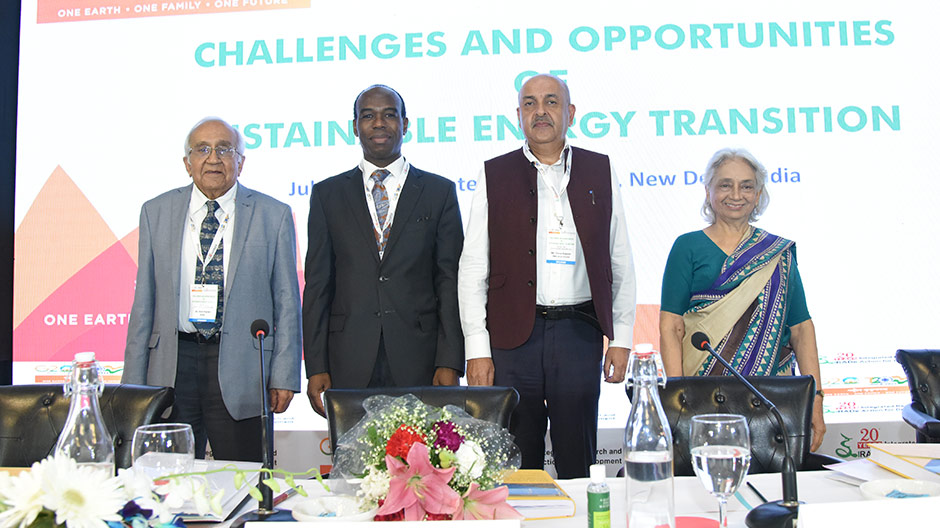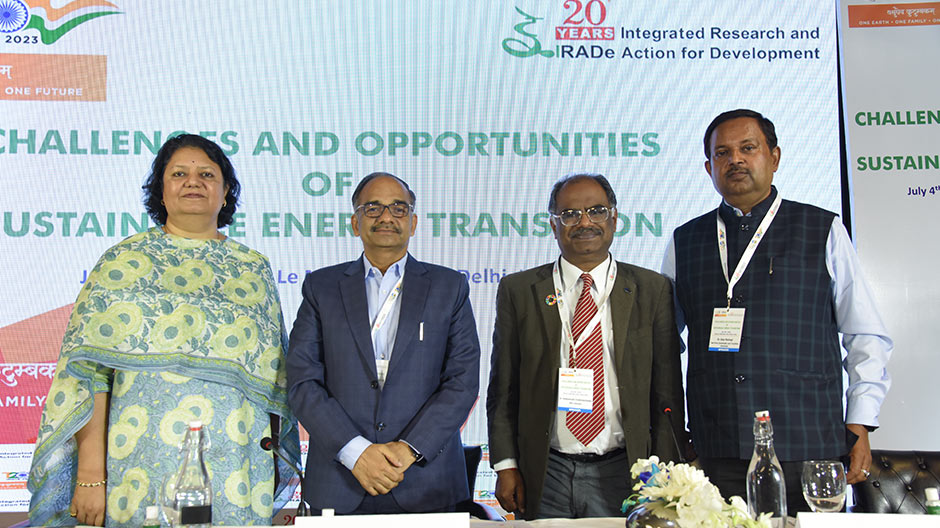Background and Context
Over the last two centuries, the world has seen several Energy Transitions. From biofuels to coal, both solid fuels, then to less polluting liquid and gas and then from stock to natural-flow-based cleaner resources which are renewables. Their advantages and disadvantages differ and each is cleaner and require new technologies for the demand side as well. There are 2.3 billion people who have not yet experienced the first transition of biomass to fossil fuels or electricity.
India’s Presidency needs to strengthen the voice of the South and also focus on affordability. Five pillars of supporting core energy transitions are: accelerating the deployment of renewable energy sources such as solar and onshore wind in all countries, scaling up the deployment of newer technologies such as offshore wind, battery storage and green hydrogen, promoting supply and demand side efficiency, encouraging market-based approaches and assisting developers to provide bankable projects, prioritizing the decarbonisation of the industrial and transport sector, while ensuring Just Transition.
Decoupling of economic growth and emissions should happen through clean energy, renewables and energy efficiency. While surveying varying progress made by various regions, it is clear that there should be resource diversity, high grid connectivity and institutions to support the transition. A holistic approach has to take account of the entire supply chain and actors involved in it. For example, for phasing down the use of fossil fuels, not only the coal mines but the whole coal supply chain that connects mining, transport, cleaning and processing, and user industries such as power plants, should be considered. The revenues, taxes and jobs are involved at each step.

Key Recommendations
- Energy Transition Pathways: Sustainable energy transition should consider all stakeholders at various stages of the transition aspiring to leapfrog to a clean energy future that is just and equitable. Every country would need to pursue its own unique path to energy transition. For some countries, it can transform economies. The process of transition should be inclusive involving people across gender, income groups and regions. Energy Transition pathways have to ensure energy security Energy Transition plans should be short-term, medium term and long term reaching to net zero goals. Medium-term plans could include steps like clean coal technologies, and decarbonising coal transport through conveyor belt systems instead of diesel-based mobility.
- Regional Integration and Grid Interconnections: Regional integration through cross-border grid interconnections are important for facilitating the energy transition of smaller countries in a cost- effective manner. Cross-border grid interconnections can also reduce the requirement of setting up expensive storage facilities for intermittent RE electricity.
- Decarbonisation of Industrial Processes: Stronger focus is required on the electrification of industrial processes for enhancing demand for renewable sources-based electricity. Biomass-based energy solutions have significant potential in various demand segments which need to be tapped more aggressively. Emerging efficient technologies should be scaled up and made more economically viable.
- Worldwide Large scale RE Investments: Most of the new RE investments are happening in China, the US and the EU. There is a need to accelerate RE investments in regions which are going to see rapid growth in demand for energy like Asia and ASEAN. In emerging and developing economies excluding China which account for 2/3rd of the world’s population, the share of the total clean energy investment is only 15%. To increase investments in such countries, the cost of capital for clean energy projects should be brought down with low-cost finane. Currently, the cost of capital for clean energy projects in emerging economies outside China is two to three times higher than in developed countries.
- Access to Technology and Low-Cost Finance: Access to technologies and low-cost finance is a prerequisite for making energy transition in developing countries affordable. For energy transition, the issue of accessibility of technology and its modifications required to suit local circumstances need to be also addressed. These should be considered as global public goods so that the issue of accessibility is dealt with. Public finance can be leveraged by providing the same through multilateral and development banks (MDBs) to hedge the risks of private finance. Historical emissions from 1990 to 2023 that are parked in the global GHG parking space can be charged a notional fee of one dollar per tonne of carbon dioxide to mobilize finance.
- Developing local supply chains: Local manufacturing of RE project equipment needs to be expanded in order to avoid increased import dependence and job losses in the process of transition from fossil fuel-based energy supply to RE-based capacity expansion.
- Institutional Mechanisms: Just Energy Transition requires a holistic approach across various sectors of the economy. Therefore, it is recommended that appropriate institutions are set up at national and provincial levels to plan and oversee timely actions for Just Energy Transition. These institutions need not wait for a comprehensive national plan and should start working on the approach of building blocks.
- Consensus Building: Energy Transition should be people-centric. Energy transition can be successfully implemented only if consensus is built among various stakeholders in the country. Federal Governments need to handhold and support provincial Governments in implementing less painful energy transitions in their geographies, with due attention to state-specific circumstances.

- Energy Efficiency: Energy efficiency plays a significant role in reducing electricity demand by approximately 40-50%, highlighting its substantial impact that should be prioritized. Buildings are consuming a lot of energy today which is going to go up further as we urbanise. In platinum-rated energy-efficient buildings, we have reduced energy consumption by 85%, Out of this 85%, only 15% could be attributed to architectural redesign of the building, while significant impact comes from efficient Heating, Ventilation and Air Conditioning (HVAC), equipment efficiency, better management and so on. Hence, a well-directed push for energy efficiency programs for air conditioners and other types of equipment is needed. Artificial intelligence can also be incorporated so that energy-efficient equipment is used even more efficiently. Also, at least 50% of new buildings to be built by 2030 and beyond must be more than 50% more efficient than the conventional building stock. The cooling sector should be considered as an emerging hard-to-abate sector. We are yet to penetrate efficiency in cooling and it needs further attention. If we aspire to attain sustainable development goals and the Paris Agreement target, the efficiency agenda should be pushed.
- Smooth Transition: Technological improvements to bring down the cost of green hydrogen and to make it economical will take time and till then, blending of green hydrogen can be prioritized. Hydrogen-based technology can be applied to not only heavy-duty trucks but also to international shipping and air travels.
- Demand-side Management: The programs and policies from the demand side are key factors for decisions related to the energy transition pathway, hence more emphasis is required on demand management. Different countries might have different pathways. However, demand-side management will remain crucial for all since it will account for 40% of actions to achieve net zero.
- Mobilizing Finance: In emerging and developing economies, clean energy investment is primarily dependent on public finance. High dependency on a particular type of finance is not feasible and all sources of finance such as private, public, concessional, etc. are required to meet investment targets. A broader focus on the following levers to mobilize private finance is required –
- Policy reforms and strengthened institutional capacity
- Increase in concessional finance to the tune of at least 80-100 billion dollars each year. Currently, for every dollar of public money, there is an additional mobilization of only 30 cents of private money. This ratio has to be reversed and the focus has to shift towards de- risking private finance.
- New financial instruments and platforms such as carbon markets, and green and sustainability-linked loans need to be deve
- More emphasis on local capital markets and financial systems which can help mobilize domestic finance is required.
Various areas such as low-emission fuels, energy efficiency, grids and storage, low-emission power need to be addressed. A sevenfold increase is required in clean energy investment in emerging economies over the next ten years across all fields.




